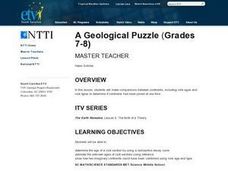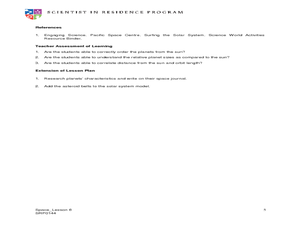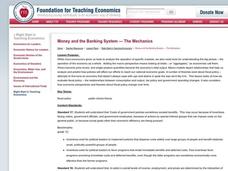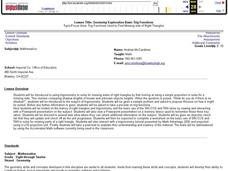Curated OER
A Geological Puzzle
Students compare and contrast the various types of rocks on each continent. In groups, the calculate the rock ages and types to determine if the continents, in their opinion, were joined at one time. They develop two imaginary...
Curated OER
Let's Heat Things Up!
Students build and evaluate simple models to understand the greenhouse effect. They explore the role of increased greenhouse gas concentration in global warming, and the implications of global warming theory for engineers, themselves...
Curated OER
Art and Anatomy: The Vitruvian Teen
Twelfth graders create an artistic version of a Vetruvian teen. In this anatomy lesson, 12th graders design an experiment to test the theory of the ideally proportioned man. They present their findings in class.
Chymist
The Solubility of a Salt in Water at Various Temperatures
An educational lesson allows young chemists to test the solubility of different types of salt at various temperatures. Groups create a graph using data from unsaturated, saturated, and supersaturated solutions.
Curated OER
Probability: The Study of Chance
Students practice the basic principles of probability by conducting an experiment, determining if a game is fair, collecting data, interpreting data, displaying data, conducting analysis, and stating and applying the rule for probability.
Curated OER
Conic Sections and Locii
Students differentiate between ellipse and hyperbola. In this algebra lesson, students graph and solve elliptical equations. They use the cabri program to create the different conics and move them around.
Curated OER
Compound Locus
Students investigate circles and compound locus. In this geometry lesson, students identify the distance from a point to a line. They use Cabri software to create lines and circles.
Curated OER
Leonardo da Vinci
Students select appropriate tools and technology to perform tests, collect data, and display data. They construct appropriate graphs from data and develop qualitative statements about the relationships between variables.
Curated OER
Would You Believe Your Eyes?
Students study the parts and functions of the human eye. They create dodecagons which are twelve-sided figures with twelve equal angles and share these with the class so that each student can begin to see how many different illusions can...
Curated OER
Space: Our Star, the Sun, and Its Friends, the Planets
Students examine the solar system. In this space instructional activity, students identify the order of the planets and their relative size to the sun. Students create a scale model of our solar system using a variety of household objects.
Curated OER
Maxima and Minima Problems
Students calculate the maxima and minima of quadratic equations. For this calculus lesson, students apply the derivatives by finding the maxima and minima using real life application. They solve optimization using the derivative.
Curated OER
Money and Banking
Students explore the role of government in the economy market. In this economics lesson, students analyze the decision making and how it takes into consideration additional cost, benefits and public awareness of what they are trying to...
Curated OER
How Markets Work
Learners explore the role of government in the economy market. In this economics instructional activity, students analyze the decision making and how it takes into consideration additional cost, benefits and public awareness of what they...
Curated OER
Birthday Problem
Young scholars identify the probability of an event occurring. Learners explore the complement of an event in finding why an event will not happen. They also explore basics of probability within algebra.
Curated OER
Interior/Exterior Polygon Angles and Tessellations
Students discover the sum of the interior and exterior angles of several polygons. For this Geometers sketchpad lesson, students work in groups to find the stated measurements of triangles, quadrilaterals, pentagons and hexagons....
Curated OER
Four Color Map
Learners explore geometry by completing a color puzzle. In this shape identification lesson, students utilize deductive reasoning to complete a Google SketchUp puzzle with trapezoid, triangles and rectangular shapes. Learners...
Curated OER
Geometry Exploration Basic Trig Functions
Tenth graders solve for missing sides on a triangle using the Pythagorean Theorem. In this geometry lesson, 10th graders are introduced to basic trigonometry functions as they solve problems of right triangles. They discuss the...
Curated OER
How Probable is It?
Students explore probability. In this probability lesson, students look at videos and websites where they discover probability facts that can be used in situations. They determine the probability of different events.
Curated OER
Probability and Expected Value
Students collect data and analyze it. In this statistics lesson, students make predictions using different outcomes of trials.
Curated OER
Zoom Out
Learners explore visual perception and how objects change as distance changes. In this distance and vision lesson, students practice their scientific inquiry skills. Learners practice drawing objects from different points of view in...
Curated OER
Coloring Interval Graphs
Young scholars investigate planning an activity and getting it done on time. In this algebra instructional activity, students define vocabulary words related quadratic equations, including the vertex and intervals. They figure a good way...
Curated OER
Beads, Balls, and Beakers
Learners analyze the amount of space required to pack round objects. In this geometry activity, students practice using space economically by practicing packing spheres into beakers. They then translate this concept to molecules being...
Curated OER
Multiple Intelligences
Students investigate Gardner's theory of multiple intelligences. In this research based lesson, students compare theories of intelligences and examine the implications of using these theories in schools and society.
Curated OER
Prime Factors
Fifth graders review the concept of prime factorization. Then, they use the rules for divisibility and other notions to find the prime factorization of unfamiliar numbers. They solve problems in a whole class setting.

























